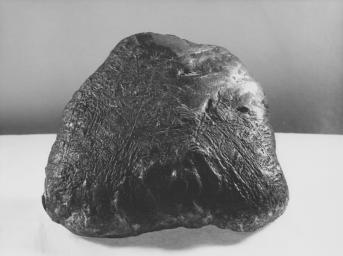
|
Iron-Nickel Meteorite from Texas with Triangle-Pattern Texture
- Click the image above for a larger view
- Full-Res JPEG (3840 x 2864) (927.9 kB)
- Full-Res TIFF (3840 x 2864) (11.0 MB)
Caption:
This iron-nickel meteorite found near Fort Stockton, Texas, in 1952 shows a surface texture similar to some portions of the surface of an iron-nickel meteorite that NASA's Mars Exploration Rover Opportunity found on Mars in July 2009. The Fort Stockton meteorite is about 15 centimeters (6 inches) across and is in the collection of Texas Christian University.
The triangular pattern visible on the surface of this meteorite is commonly seen inside iron-nickel meteorites that have been cut, polished and etched. On the Fort Stockton meteorite and apparently on the "Block Island" meteorite on Mars, long exposure to wind-blown sand has brought out the texture.
This triangular pattern in the texture of iron-nickel meteorites, called the Widmanstatten pattern, formed more than 4.5 billion years ago as the metal cooled. One iron-nickel mineral, kamacite, formed thin layers along the surface of crystals of another, taenite, which contains less nickel. The two minerals differ in their resistance to etching by acid or erosion by wind-blown sand, so those processes can make the pattern visible.
Cataloging Keywords:
| Name | Value | Additional Values |
|---|---|---|
| Target | Mars | |
| System | ||
| Target Type | Planet | |
| Mission | Mars Exploration Rover (MER) | |
| Instrument Host | Opportunity (MER-B) | |
| Host Type | Rover | |
| Instrument | ||
| Detector | ||
| Extra Keywords | Grayscale | |
| Acquisition Date | ||
| Release Date | 2009-08-06 | |
| Date in Caption | ||
| Image Credit | Smithsonian Institution | |
| Source | photojournal.jpl.nasa.gov/catalog/PIA12192 | |
| Identifier | PIA12192 | |
